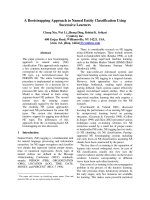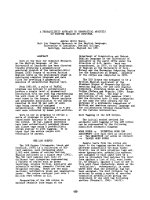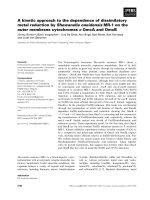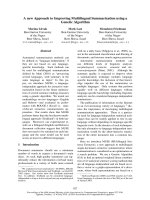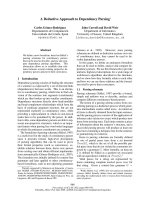Báo cáo khoa học: "A Practical Solution to the Problem of Automatic Part-of-Speech Induction from Text" pdf
Bạn đang xem bản rút gọn của tài liệu. Xem và tải ngay bản đầy đủ của tài liệu tại đây (78.95 KB, 4 trang )
Proceedings of the ACL Interactive Poster and Demonstration Sessions,
pages 77–80, Ann Arbor, June 2005.
c
2005 Association for Computational Linguistics
A Practical Solution to the Problem of
Automatic Part-of-Speech Induction from Text
Reinhard Rapp
University of Mainz, FASK
D-76711 Germersheim, Germany
Abstract
The problem of part-of-speech induction
from text involves two aspects: Firstly, a
set of word classes is to be derived auto-
matically. Secondly, each word of a vo-
cabulary is to be assigned to one or sev-
eral of these word classes. In this paper
we present a method that solves both
problems with good accuracy. Our ap-
proach adopts a mixture of statistical me-
thods that have been successfully applied
in word sense induction. Its main advan-
tage over previous attempts is that it re-
duces the syntactic space to only the most
important dimensions, thereby almost eli-
minating the otherwise omnipresent prob-
lem of data sparseness.
1 Introduction
Whereas most previous statistical work concerning
parts of speech has been on tagging, this paper
deals with part-of-speech induction. In part-of-
speech induction two phases can be distinguished:
In the first phase a set of word classes is to be de-
rived automatically on the basis of the distribution
of the words in a text corpus. These classes should
be in accordance with human intuitions, i.e. com-
mon distinctions such as nouns, verbs and adjec-
tives are desirable. In the second phase, based on
its observed usage each word is assigned to one or
several of the previously defined classes.
The main reason why part-of-speech induction
has received far less attention than part-of-speech
tagging is probably that there seemed no urgent
need for it as linguists have always considered
classifying words as one of their core tasks, and as
a consequence accurate lexicons providing such
information are readily available for many lan-
guages. Nevertheless, deriving word classes auto-
matically is an interesting intellectual challenge
with relevance to cognitive science. Also, advan-
tages of the automatic systems are that they should
be more objective and can provide precise infor-
mation on the likelihood distribution for each of a
word’s parts of speech, an aspect that is useful for
statistical machine translation.
The pioneering work on class based n-gram
models by Brown et al. (1992) was motivated by
such considerations. In contrast, Schütze (1993) by
applying a neural network approach put the em-
phasis on the cognitive side. More recent work in-
cludes Clark (2003) who combines distributional
and morphological information, and Freitag (2004)
who uses a hidden Marcov model in combination
with co-clustering.
Most studies use abstract statistical measures
such as perplexity or the F-measure for evaluation.
This is good for quantitative comparisons, but
makes it difficult to check if the results agree with
human intuitions. In this paper we use a straight-
forward approach for evaluation. It involves check-
ing if the automatically generated word classes
agree with the word classes known from grammar
books, and whether the class assignments for each
word are correct.
2 Approach
In principle, word classification can be based on a
number of different linguistic principles, e.g. on
phonology, morphology, syntax or semantics.
However, in this paper we are only interested in
syntactically motivated word classes. With syntac-
tic classes the aim is that words belonging to the
same class can substitute for one another in a sen-
tence without affecting its grammaticality.
As a consequence of the substitutability, when
looking at a corpus words of the same class typi-
cally have a high agreement concerning their left
and right neighbors. For example, nouns are fre-
quently preceded by words like a, the, or this, and
succeeded by words like is, has or in. In statistical
77
terms, words of the same class have a similar fre-
quency distribution concerning their left and right
neighbors. To some extend this can also be ob-
served with indirect neighbors, but with them the
effect is less salient and therefore we do not con-
sider them here.
The co-occurrence information concerning the
words in a vocabulary and their neighbors can be
stored in a matrix as shown in table 1. If we now
want to discover word classes, we simply compute
the similarities between all pairs of rows using a
vector similarity measure such as the cosine coef-
ficient and then cluster the words according to
these similarities. The expectation is that unambi-
guous nouns like breath and meal form one cluster,
and that unambiguous verbs like discuss and pro-
tect form another cluster.
Ambiguous words like link or suit should not
form a tight cluster but are placed somewhere in
between the noun and the verb clusters, with the
exact position depending on the ratios of the occur-
rence frequencies of their readings as either a noun
or a verb. As this ratio can be arbitrary, according
to our experience ambiguous words do not se-
verely affect the clustering but only form some
uniform background noise which more or less can-
cels out in a large vocabulary.
1
Note that the cor-
rect assignment of the ambiguous words to clusters
is not required at this stage, as this is taken care of
in the next step.
This step involves computing the differential
vector of each word from the centroid of its closest
cluster, and to assign the differential vector to the
most appropriate other cluster. This process can be
repeated until the length of the differential vector
falls below a threshold or, alternatively, the agree-
ment with any of the centroids becomes too low.
This way an ambiguous word is assigned to several
parts of speech, starting from the most common
and proceeding to the least common. Figure 1 il-
lustrates this process.
1
An alternative to relying on this fortunate but somewhat un-
satisfactory effect would be not to use global co-occurrence
vectors but local ones, as successfully proposed in word sense
induction (Rapp, 2004). This means that every occurrence of a
word obtains a separate row vector in table 1. The problem
with the resulting extremely sparse matrix is that most vectors
are either orthogonal to each other or duplicates of some other
vector, with the consequence that the dimensionality reduction
that is indispensable for such matrices does not lead to sensi-
ble results. This problem is not as severe in word sense induc-
tion where larger context windows are considered.
The procedure that we described so far works in
theory but not well in practice. The problem with it
is that the matrix is so sparse that sampling errors
have a strong negative effect on the results of the
vector comparisons. Fortunately, the problem of
data sparseness can be minimized by reducing the
dimensionality of the matrix. An appropriate alge-
braic method that has the capability to reduce the
dimensionality of a rectangular matrix is Singular
Value Decomposition (SVD). It has the property
that when reducing the number of columns the
similarities between the rows are preserved in the
best possible way. Whereas in other studies the
reduction has typically been from several ten thou-
sand to a few hundred, our reduction is from sev-
eral ten thousand to only three. This leads to a very
strong generalization effect that proves useful for
our particular task.
left neighbors right neighbors
a we
the
you
a can
is well
breath
11 0 18 0 0 14 19 0
discuss
0 17 0 10
9 0 0 8
link 14 6 11 7 10 9 14 3
meal 15 0 17 0 0 9 12 0
protect
0 15 1 12
14 0 0 4
suit 5 0 8 3 0 8 16 2
Table 1. Co-occurrence matrix of adjacent words.
Figure 1. Constructing the parts of speech for can.
3 Procedure
Our computations are based on the unmodified text
of the 100 million word British National Corpus
(BNC), i.e. including all function words and with-
out lemmatization. By counting the occurrence
frequencies for pairs of adjacent words we com-
piled a matrix as exemplified in table 1. As this
matrix is too large to be processed with our algo-
rithms (SVD and clustering), we decided to restrict
the number of rows to a vocabulary appropriate for
evaluation purposes. Since we are not aware of any
standard vocabulary previously used in related
work, we manually selected an ad hoc list of 50
78
words with BNC frequencies between 5000 and
6000 as shown in table 2. The choice of 50 was
motivated by the intention to give complete clus-
tering results in graphical form. As we did not
want to deal with morphology, we used base forms
only. Also, in order to be able to subjectively judge
the results, we only selected words where we felt
reasonably confident about their possible parts of
speech. Note that the list of words was compiled
before the start of our experiments and remained
unchanged thereafter.
The co-occurrence matrix based on the restricted
vocabulary and all neighbors occurring in the BNC
has a size of 50 rows times 28,443 columns. As our
transformation function we simply use the loga-
rithm after adding one to each value in the matrix.
2
As usual, the one is added for smoothing purposes
and to avoid problems with zero values. We de-
cided not to use a sophisticated association meas-
ure such as the log-likelihood ratio because it has
an inappropriate value characteristic that prevents
the SVD, which is conducted in the next step, from
finding optimal dimensions.
3
The purpose of the SVD is to reduce the number
of columns in our matrix to the main dimensions.
However, it is not clear how many dimensions
should be computed. Since our aim of identifying
basic word classes such as nouns or verbs requires
strong generalizations instead of subtle distinc-
tions, we decided to take only the three main di-
mensions into account, i.e. the resulting matrix has
a size of 50 rows times 3 columns.
4
The last step in
our procedure involves applying a clustering algo-
rithm to the 50 words corresponding to the rows in
the matrix. We used hierarchical clustering with
average linkage, a linkage type that provides con-
siderable tolerance concerning outliers.
4 Results and Evaluation
Our results are presented as dendrograms which in
contrast to 2-dimensional dot-plots have the advan-
tage of being able to correctly show the true dis-
tances between clusters. The two dendrograms in
figure 2 where both computed by applying the pro-
cedure as described in the previous section, with
2
For arbitrary vocabularies the row vectors should be divided
by the corpus frequency of the corresponding word.
3
We are currently investigating if replacing the log-likelihood
values by their ranks can solve this problem.
4
Note that larger matrices can require a few more dimensions.
the only difference that in generating the upper
dendrogram the SVD-step has been omitted,
whereas in generating the lower dendrogram it has
been conducted. Without SVD the expected clus-
ters of verbs, nouns and adjectives are not clearly
separated, and the adjectives widely and rural are
placed outside the adjective cluster. With SVD, all
50 words are in their appropriate clusters and the
three discovered clusters are much more salient.
Also, widely and rural are well within the adjective
cluster. The comparison of the two dendrograms
indicates that the SVD was capable of making ap-
propriate generalizations. Also, when we look in-
side each cluster we can see that ambiguous words
like suit, drop or brief are somewhat closer to their
secondary class than unambiguous words.
Having obtained the three expected clusters, the
next investigation concerns the assignment of the
ambiguous words to additional clusters. As de-
scribed previously, this is done by computing dif-
ferential vectors, and by assigning these to the
most similar other cluster. Hereby for the cosine
similarity we set a threshold of 0.8. That is, only if
the similarity between the differential vector and
its closest centroid was higher than 0.8 we as-
signed the word to this cluster and continued to
compute differential vectors. Otherwise we as-
sumed that the differential vector was caused by
sampling errors and aborted the process of search-
ing for additional class assignments.
The results from this procedure are shown in ta-
ble 2 where for each of the 50 words all computed
classes are given in the order as they were obtained
by the algorithm, i.e. the dominant assignments are
listed first. Although our algorithm does not name
the classes, for simplicity we interpret them in the
obvious way, i.e. as nouns, verbs and adjectives. A
comparison with WordNet 2.0 choices is given in
brackets. For example, +N means that WordNet
lists the additional assignment noun, and -A indi-
cates that the assignment adjective found by the
algorithm is not listed in WordNet.
According to this comparison, for all 50 words
the first reading is correct. For 16 words an addi-
tional second reading was computed which is cor-
rect in 11 cases. 16 of the WordNet assignments
are missing, among them the verb readings for re-
form, suit, and rain and the noun reading for serve.
However, as many of the WordNet assignments
seem rare, it is not clear in how far the omissions
can be attributed to shortcomings of the algorithm.
79
accident N expensive A reform N (+V)
belief N familiar A (+N) rural A
birth N (+V) finance N V screen N (+V)
breath N grow V N (-N) seek V (+N)
brief A N imagine V serve V (+N)
broad A (+N) introduction N slow A V
busy A V link N V spring N A V (-A)
catch V N lovely A (+N) strike N V
critical A lunch N (+V) suit N (+V)
cup N (+V) maintain V surprise N V
dangerous A occur V N (-N) tape N V
discuss V option N thank V A (-A)
drop V N pleasure N thin A (+V)
drug N (+V) protect V tiny A
empty A V (+N) prove V widely A N (-N)
encourage V quick A (+N) wild A (+N)
establish V rain N (+V)
Table 2. Computed parts of speech for each word.
5 Summary and Conclusions
This work was inspired by previous work on word
sense induction. The results indicate that part of
speech induction is possible with good success
based on the analysis of distributional patterns in
text. The study also gives some insight how SVD
is capable of significantly improving the results.
Whereas in a previous paper (Rapp, 2004) we
found that for word sense induction the local clus-
tering of local vectors is more appropriate than the
global clustering of global vectors, for part-of-
speech induction our conclusion is that the situa-
tion is exactly the other way round, i.e. the global
clustering of global vectors is more adequate (see
footnote 1). This finding is of interest when trying
to understand the nature of syntax versus semantics
if expressed in statistical terms.
Acknowledgements
I would like to thank Manfred Wettler and Chris-
tian Biemann for comments, Hinrich Schütze for
the SVD-software, and the DFG (German Re-
search Society) for financial support.
References
Brown, Peter F.; Della Pietra, Vincent J.; deSouza, Peter
V.; Lai, Jennifer C.; Mercer, Robert L. (1992). Class-
based n-gram models of natural language. Computa-
tional Linguistics 18(4), 467-479.
Clark, Alexander (2003). Combining distributional and
morphological information for part of speech induc-
tion. Proceedings of 10th EACL, Budapest, 59-66.
Freitag, Dayne (2004). Toward unsupervised whole-
corpus tagging. Proceedings of COLING, Geneva,
357-363.
Rapp, Reinhard (2004). A practical solution to the prob-
lem of automatic word sense induction. Proceedings
of ACL (Companion Volume), Barcelona, 195-198.
Schütze, Hinrich (1993). Part-of-speech induction from
scratch. Proceedings of ACL, Columbus, 251-258.
0.8
0.4
0.0
1.0
0.5
0.0
Figure 2. Syntactic similarities with (lower dendrogram) and without SVD (upper dendrogram).
80


